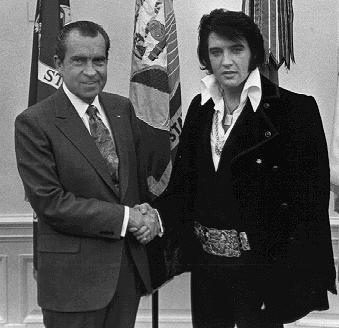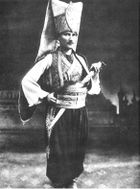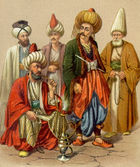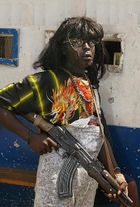History of the War on Drugs
The descriptive term War on Drugs was first used by the United States President Richard Nixon in 1969. During a speech to the "Mothers of America" he proposed the compulsory use of stimulants for US army personnel on active service. Nixon insisted that going to war on drugs would allow GIs to fight for up to 36 hours at a stretch and hasten the end of Communist insurgency across South East Asia. He then handed over control of this radical innovation to the Pentagon's so called High-command. However, credit for the idea of going to war high on drugs cannot be claimed by Whitehouse think-tanks alone, as the idea seems to have been prevalent throughout history.
Historical evolution
War is one of man’s most consistently popular inventions and those involved in it have often sought out natural and artificial means to heighten their enjoyment of maiming their neighbour. From our earliest days, warriors have uttered war cries, decorated themselves with war paint and adopted flamboyant battle dress before committing themselves to the fray. But why? Researchers have shown how close harmony singing stimulates a rush of endorphins and a natural high in members of male voice choirs. Though there is no evidence of chemical stimulation, the opportunity to apply make-up and unusual clothing still draws thousands of high-spirited young males to performances of the Rocky Horror Show, creating a terrifying camaraderie. Famously, Scottish Highland warriors have traditionally sported the kilt to add a cross-dressing frisson to the pleasure they gained from slicing Sassenachs with claymores, many going commando at the same time for an additional thrill. Even so, warriors have ever thirsted for additional stimulation.
But just when did man first go into battle stoned, and how has the production of drugs for warfare affected human history and the shape of the world around us?
The Vikings
From the eighth century until the late eleventh, Viking raiders expanded from their Scandinavian coastal bases to ransack and settle much of Northern Europe, Russia, the Atlantic islands and even parts of the Mediterranean. Why such a few thousand obscure pastoralists and fishermen braved the high seas in pursuit of plunder is still debated. Historians seem sure that land pressure played a part and also the need to export quality flat-pack furniture from their native pine forests in the name of their pagan god, Ikea. How such small groups of men dominated strong nation states such as France and England is truly a mystery and the use of narcotics should not be ruled-out.
Initially, Viking raiders had no need of drugs, for they had the element of surprise in their favour. From 806 AD onwards, longboats began to swoop down on undefended monasteries to loot and pillage, inflicting social democracy and lightly spiced meatballs on the isolated villages of Northumbria and Ireland. There is evidence, however, that Viking raids were welcomed in some parts since death at the hands of a pagan guaranteed a place in heaven. According to Abbess Eadgythelfryth, the nuns of St. Waffleburga’s Abbey looked forward to the visits of “rough-handed, horny [helmeted] men of the ocean” and had had little fear of “being confined to their cells and tortured with steam from hot rocks doused in water. Yea, until their very skin seemed ready to melt from their backs. Thence did the Northmen scourge the faithful with withies of beech branches and cast them into the snow and ravish them.” This, it seems, was mere opportunism but soon the Vikings began to face organized armies arranged in seemingly impenetrable shield walls. There was a clear choice; either investigate the possibilities of going to “War on Drugs” or withdraw to the homeland. Inevitably, they just could not say "no".
Bezerkers were warriors renowned for their disregard of their own safety. Often naked, they charged even the most fearsome opposing armies, foaming at the mouth. This violent, seemingly semi-conscious state was called the Beserkergang and was a feature of Viking battles for 200 years. Contemporary accounts describe the ferocity of Berserker charges breaking the defensive line and allowing other Vikings to pick off individual defenders. There has been much debate about what inspired their savageness over the years, with many suggesting the usage of Fly agaric, a naturally occurring fungus of the forests of Northern Europe. The Stavangar Shroom Saga gives some evidence for this in the passage which describes the discovery of Vinland (North America) and the response to the attacks of indigenous people.
| “ | Snorri Gudmansson and his three sons followed the native warriors into the forest and were gone many hours. Leif Nokiasson had already begun to hum the ringtone of mourning when they returned telling tales of bright flashing lights, frogs which spoke of great dangers in the tree-tops and ants which crawled beneath men's skins. And we were much a-feared. | ” |
The climate of Europe changed as it approached the Medieval period and fly agaric would have become increasingly difficult to find. Interestingly, it is at this point that the Vikings’ fortunes began to decline. The last notable battle of the Viking age was their defeat by King Harold Godwineson of England at Stamford Bridge in 1066. By this time the Berserkergang state appears to have been being induced solely by alcohol in the form of mead. The Saxons are reputed to have utilized this information by circulating news of a free bar prior to hostilities, ringing a bell and shouting “Last orders, vikings, please.”
The English King is said to have personally slain the Viking leader, King Harald Hardrada (Norse for 'Hard Drinker') while the Norwegian was still claiming his Saxon counterpart was his “Best mate.” Hardrada’s last words are recorded in the Saxon Chronicle (the official History of the English people) as “I fuckin’ love you, man.”
Muslim Caliphate
When Islam exploded out of the Arabian peninsula like a suicide bomber from a bus queue, it seemed unstoppable. In a few short decades, the Islamic Empire covered not only the Middle East, but also North Africa, Iberia, the Balkans and West Yorkshire. How was it possible for a small sect to expand so quickly? Leaders of the Moorish Empire realised that they could not rely on the traditional levies and conscripts if they were to spread their faith. When religious devotion alone could no longer guarantee victory, Muslim leaders turned to Chemistry.
The Janissaries
Janissaries were an early attempt to create a unit with an individual identity strong enough to inspire reckless loyalty. Janissaries were not recruited but were abducted as children from Christian parents in what is now Yugoslavia. They were subsequently castrated to stop them leaving the house at night in search of rodents. Unwilling to sanction the use of alcohol, Janissary leaders had decided to subtlely alter their troops' natural body-chemistry by depriving them of testosterone. Having survived such an inauspicious start to their military career, a future Janissary could expect up to twelve years of military training and harsh punishments for minor offences. However, once training was completed, a Janissary was without doubt the finest soldier anywhere in the world. Sadly, being ripped from the arms of their mothers and forcibly detached from their gonads did not always inspire the desired level of loyalty. After a series of rebellions the Janissaries were consigned to history. This bold experiment in the adjustment of natural homones in the War on Drugs had ultimately failed.
The Hashshahsin
The Hashshahsin by contrast were native born and therefore more reliable and less likely to volunteer for units which had genital mutilation as an initiation rite. But how else could commanders inspire them to acts of fearless bravery without the alcohol available to infidel troops? Fortunately, by the time of the Hashshashin, Islam had spread east into Central Asia and access to the rich poppy-fields of Afghanistan allowed them to revive the idea of War on Drugs in its purest form.
The Hashshashin were expert warriors and their legendary deeds whilst out of it on Hasheesh are remembered in myth and in the English word "Assassin". Their bravery in battle was second to none and they were masters of disguise. As the word assassin suggests, they could be hired for contract killings. Intended victims would often wake with an Hashshashin dagger on their pillow, knowing that if they failed to flee they'd soon be holding up a flyover on the Silk Road.
In the short term, the Hashshashin programme was a success. The ingestion of opiates dulled the pain of battle-injuries and clouded the judgement of the soldier, encouraging him to fight when producing a note from their mother would otherwise have seemed a more attractive alternative. However, even the Hashshashin idea was eventually discredited, as Muslim commanders realised that recruits were spending less time training for warfare and more breaking into houses in search of money to pay dealers. Crime levels in Damascus reached epidemic proportions and the group were eventually disbanded when Mongol warriors cut supplies from the Golden Triangle in Asia. Enemy forces over-ran Hashshashin camps while their occupants were howling in torment and shivering in their tents despite the 40 degree heat. This is the first historical account of the condition we now call Cold Turkey, though, interestingly, it seems to have happened in Syria. For years after their formal disbandment Hashshahsin were a familiar sight in the bazaars and suqs of the Middle East, often sitting outside magic-carpet stalls plaintiffly reciting the Hashshashin war-cry "Biggy Shoo" over and over.
Pre-colonial Americas
The Incas
In the year 1430 the people who would become the Inca were still a small tribe of llama enthusiasts in the Cuzco valley of central Peru. In a dizzying whirl of conquest they subjugated most of South America, from the Atacama desert of Chile to southern Colombia. Surely none of this could have been achieved without the liberal use of psychoactive intoxicants.
For centuries South American tribes had chewed the coca leaf to relieve altitude sickness and to give themselves confidence on the dance floors of Bolivia's vibrant nighclub scene. However, according to Incan traditional history, it was Manco Capac who first realised that simply steeping the crushed leaves in kerosene derived from Peru's Chacopopos oil field overnight, refluxing gently for several hours and then treating with alternate acidic and alkaline mixtures, retreating with kerosene, crystalising and dissolving in sulphuric acid produced a much more potent form of the narcotic. Primitive Incan Mass Spectrometry suggested that the crystals formed were up to 60% pure cocaine.
Manco Capac himself is thought to have ingested so much cocaine that he came to believe himself to be the Sun-God. His followers were sufficiently over-stimulated to take this announcement at face-value. The Inca people enjoyed their military successes but found peace-time stressful. Eventually they learned to occupy their restless energies in frenetic bouts of meaningless physical exertion, such as digging irrigation canals that ran uphill.
Throughout the fifteenth century the Incan forces were rampant. They conquered the Chimor and Chachapoya people in an unstoppable march along the spine of the continent, suffering only minor set-backs and nasal-bleeding along the way. In the 1520s, however, the empire was itself over-run by a small force of Spanish conquistadors. Interestingly, the Spanish were themselves so strung-out on peyote confiscated from their Aztec conquests that they believed their bodies had merged with those of their horses. They also believed that the resulting "Battle Centaur" was impervious to Inca weapons.
The Aztecs
We can only now speculate how the conquistadors had conquered the Aztec empire in the previous decade, as accounts are sparse and conflicting. Climate scientists have speculated that a severe El Nino in 1517-1518 would have had disastrous effects on the harvest of the cactus from which Aztec peyote was manufactured. Aztec warriors going to war sober may have paused to consider the discrepancy between Spanish armaments and the primitive nature of their stone and copper weaponry. Minds not clouded by drugs can only have wondered whether brightly coloured feathers were really sufficient defence against an enemy armed with muskets. At the same time, the Spanish New World Empire was known to have had a glut of Communion wine and it may well have been this which inspired the heroic bravery required for a mere eight men to conquer the whole of Mexico.
In his autobiographical account of the campaign, "Whacking the Wetbacks", Hernan Cortes admits that he spent much of the campaign "Just wasted, man. Just totally fuck-faced from Yucatan to Tenochtitlan."
United States
World War II
Americans dislike war and so generally avoid the first few years of a conflict, joining in when the existing combatants are already tired and can easily be persuaded to surrender. During the Second World War, President Roosevelt found Nazi Germany strangely reluctant to comply. He demanded new and innovative ideas from American scientists to help change the mind of their intrasigent, unitesticular Führer. A nuclear weapons programme was suggested as early as 1942 but was dismissed as Germans were considered "too white to vapourise". While the United States Air Force helped Britain's Royal Air Force to incinerate their Teutonic enemy instead, American airmen began to experiment with amphetamines. These new stimulants allowed pilots to fly further without losing concentration, to react more quickly and more aggressively to fighter attack and to communicate very quickly, if excitedly, over the intercom system.
Initial trials were highly successful and several wooden Medieval cities were reduced to ash, crippling the German war-time tourist trade. However, the experiment was already being discouraged by 1944 due to several unfortunate, friendly-fire incidents thought to be the result of amphetamine-induced paranoid delusions. Chief amongst these was the carpet-bombing of the English city of Coventry which, it seemed, had been plotting something behind the USAF's back. Following the destruction of Plymouth (which had been seeing the USAF's girl while it was at work) and the annihilation of Liverpool (which had looked at it funny) all amphetamine shipments were halted. Thereafter American aircrew were forced to go into battle armed only with overwhelming fire-power, complete mastery of the air and an abundant supply of nylon stockings. Having flown almost continually from 1942 onwards, the USAF now went into a down phase, refusing to leave the house until 1956 and waking up only when gripped by panic attacks or when the need to threaten suicide was overwhelming.
Vietnam War
By the time of the Vietnam War it was the US Army which had taken the lead in the War on Drugs. It was clear by 1971 that boys drafted from mid-western high schools, given six weeks training and a semi-auomatic did not always thrive in combat situations. It was quietly whispered in Pentagon corridors that some of these teenage boy-soldiers found being sniped at by jungle-veterans "frightening", and that night-time clashes with unseen enemies had left some feeling "scared". With longer basic-training out of the question due to the pressing demand for infantry, only Science could help. Fortunately, nature had provided a solution in the form of the cannabis plant which thrived in the tropical east.
GI's fully loaded on this miraculous wonder-weapon were notably relaxed on patrol. Confidence soared and instances of recruits fleeing in the face of the enemy fell dramatically. In parts of Khanh Hoa province, Viet Cong commanders ordered a temporary withdrawal, as their own soldiers were unerved by the giggling that their attacks provoked. Surely troops who laughed in the face of danger were to be feared. What could these foreign devils be planning that was so funny? Within months the tide of the war seemed to be turning in favour of democracy.
However, just as US generals considered taking the fight into North Vietnam, matters took a left turn. Many soldiers refused to discharge their weapons for fear of harming friendly trees, while others seemed unable to remember to load their rifle or which way round to hold it. Once out of combat, it became increasingly difficult to persuade recruits to move away from mess-hall refrigerators. Cannabis use was officially banned when incidences of soldiers finding meaning within the lyrics of Yes albums were confirmed.
Current developments
It is uncertain what the future holds for the idea of going to war on drugs as such developments are, as always, shrouded in secrecy. However, what is clear is that future usage of drugs in warfare seem more focussed on their use against the enemy directly. Dutch military scientists are known to be developing drugs based on Ecstacy (MDMA). This, it is thought, will be delivered as an aerosol to enemy troops in the hope of convincing them that violence will solve nothing. Early experiments in Afghanistan have proved positive with many Taliban operatives in Helmand province apparently being convinced that the world could be a better place if we all simply gave a little more love, and perhaps danced for a while.
The French Foreign Legion are said to have trialled the use of Rohypnol (the so-called "Date-rape drug") during their defence of Chad against Libyan aggression. The Organisation of African Unity recently reported the discovery of the remains of over a thousand dead Libyan soldiers in the Sahara desert. Each had been shot through the back of the head, many had their trousers on backwards. A spokesman for the Elysee Palace claimed that the Libyans had "consented".
Due to budget cuts, the British Ministry of Defence has abandoned all further research in the field, preferring to return to the traditional drug of choice for generations of British squaddies: tea.








